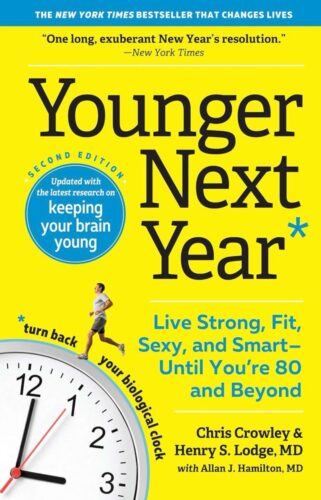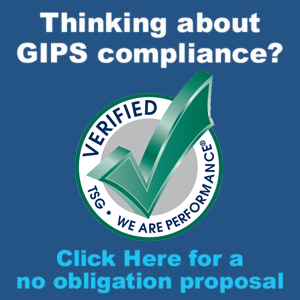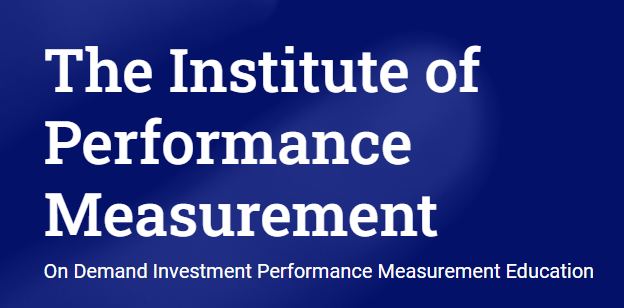GIPS® Tips

Experience “White Glove” GIPS Standards Verification With TSG
Are you tired of being treated like just another number by your GIPS verifier? At TSG, we prioritize your satisfaction and success above all else.
Partnering with us means gaining access to a team of seasoned GIPS specialists dedicated to delivering unparalleled service and exceptional value. Whether you’re seeking a new verifier, preparing for your initial verification, or just starting to explore GIPS compliance, TSG is the best choice.
Why Choose TSG?
Unmatched Expertise: Our experienced team brings unmatched proficiency in the GIPS standards, ensuring thorough and efficient (not “never-ending”) verifications.
Personalized Support: We understand that the journey toward GIPS compliance is complex. That’s why we offer ongoing support and guidance as needed, as well as access to a suite of exclusive proprietary tools, designed to make compliance and verification as easy as possible for you and your firm.
Actionable Insights: When you choose TSG, you will work with ONLY highly experienced senior-level GIPS and performance specialists. Their expertise translates into actionable advice, helping you navigate the complexities of the Standards in the most ideal way for your firm.
Hassle-Free Experience: At TSG, we guarantee your satisfaction and we do not lock our clients into long-term contracts.
Ready to Experience the TSG Difference?
Take the first step toward a better GIPS standards verification. Schedule a call or request a no-obligation proposal today at GIPSStandardsVerifications.com.
The Journal of Performance Measurement®
This month’s article brief spotlights “Attracting and Retaining Female Talent in the Investment Industry” by Jocelyn Gilligan, CFA, CIPM of Longs Peak Advisory Services.. It was published in the Summer 2025 issue of The Journal of Performance Measurement. You can access this article by subscribing (for free) to The Journal (link here).
In today’s dynamic and ever-changing business landscape, the importance of diversity and inclusion cannot be overstated. Study after study has found that diverse teams bring a multitude of perspectives that drive innovation, enhance decision-making, and ultimately, improve organizational performance. One crucial aspect of achieving diversity in an organization is ensuring equitable representation of women in the workforce, particularly in industries where they are traditionally underrepresented, such as the investment management industry. While many industry leaders express a desire to hire more qualified women, unintentional and unconscious biases can actively undermine those efforts—preventing firms from attracting top female talent and retaining them long-term. This article seeks to remind readers of the value and importance of hiring women, while subsequently offering practical strategies for attracting top female talent and ultimately retaining a diverse workforce.
To confirm your email address, click the graphic below. If you’re a subscriber but haven’t received a link to the current issue, please reach out to Doug Spaulding at DougSpaulding@TSGperformance.com.
PUZZLE TIME
We are holding the puzzle for another month. Submit your answers before December 15th.
In a room of 100 people, 99% are left-handed. How many left-handed people have to leave the room so their percentage drops to 98 percent?
Source: https://tinyurl.com/y599dav6
Upcoming Webinars / Surveys
In Case You Missed It…
Webinar Replay: Performance Measurement Technology Survey Recap
Webinar Replay: Performance Measurement in Private Equity
Webinar Replay: Performance Surprises with David Spaulding, DPS, CIPM
Webinar Replay: Should Your Firm Pursue GIPS® Compliance and Verification?
Webinar Replay: Recently Published SEC Marketing Rule FAQ
Institute / Training
Inside the Institute: A Fresh Perspective
Institute.TSGperformance.com
Link to the Class: Performance Measurement Attribution
By Jesse Teller
Module 1 – Attribution Fundamentals & Equity Attribution
Performance Attribution Module 1 focused on providing the essential material needed for a thorough understanding of what attribution is. The lesson started with the basics of attribution, which was broken down into allocation, stock selection, and currency contribution. These core components were introduced in a way that made their roles in performance measurement intuitive and logical. From there, the module walked through both absolute attribution and contribution techniques, helping to clarify how portfolio elements contribute to overall returns. Next came relative attribution, which added another layer of depth, comparing performance against benchmarks. The rationale behind why we do attribution really clicked. The framework made sense from the start, and each section built logically on the last. Dave’s use of real-world examples and logical comparisons also helped improve my understanding of the topic. Attribution is not something I have learned much about previously, so the clarity created by the examples was very beneficial. I also found that some of the formulas were hard to memorize and apply, despite a conceptual understanding. However, I know I could improve with more practice and experience.
Article Submissions
The Journal of Performance Measurement® Is Currently Accepting Article Submissions
The Journal of Performance Measurement is currently accepting article submissions on topics including performance measurement, risk, ESG, AI, and attribution. We are particularly interested in articles that cover practical performance issues and solutions that performance professionals face every day. All articles are subject to a double-blind review process before being approved for publication. White papers will also be considered. For more information and to receive our manuscript guidelines, please contact Douglas Spaulding at DougSpaulding@TSGperformance.com.
Submission deadlines
Winter Issue: January 12, 2026
Spring Issue: March 30, 2026
For any questions, please reach out to Doug Spaulding at DougSpaulding@TSGperformance.com.
Book Review
Younger Next Year,
by Chris Cowley & Henry S. Lodge, M.D.
Review by David D. Spaulding, DPS, CIPM

I first read this book around 20 years ago, and just read the revised version. My motivation may have been age-driven, given that this month I turned 75, a “milestone birthday,” so to speak.*
While I’ve been health and fitness conscious for more than 25 years, as I age it has become increasingly important. I recently remarried (on Performance Measurement Professional’s Day in 2024), and want to remain healthy for my new bride, as I tried to do for my late wife. And this book is just one of several I’ve recently read, with that aim in mind.
It’s my belief that all men over 50 should read it [there’s a version for woman, as well].
Throughout the book we see a lot of encouragement for regular exercise: they suggest we commit to six days each week … for the rest of our lives. Well, my goal has been 5-7 days a week for some time, and I typically hit the 6x/week mark. In addition to cardio, strength training is very important.
As for our diet, they do address this, and another book, which I will review next month, touches on this in greater detail.
Who doesn’t want to be healthy? We can’t control everything, of course. My late wife exercised regularly, but she was hit with a lung disease (pulmonary fibrosis), which was beyond her control. For a lifelong non-smoker, coming down with a lung disease was more than a bit frustrating, of course. Sadly, one of the book’s co-authors died too young, of an advanced stage of prostate cancer: again, something we can’t control. Let’s focus on the things we can control. Knowing that a regular fitness program will help us immensely is important.
Our attitude, of course, is also very important. One of the things I disagree with Chris Crowley, one of the authors, about is that he often speaks of being “old.” Okay, so today he’s in his early 90s, so perhaps that’s okay to do. But he was using this language when he was in his 60s and 70s. As a 75-year old, I am “older,” but I never refer to myself as being “old.” I feel so strongly about this I wrote a LinkedIn article on the subject (https://tinyurl.com/ytmtzdpx).
The book is well written, somewhat entertaining, and includes a new section that addresses ways we can reduce the risk of dementia and Alzheimer’s.
Do yourself and your loved ones a favor, especially if you’re over 50: read it! And, implement much of what it suggests.
* One question that occasionally comes up is what my plans are, and does TSG have a succession plan. Well, I have no plans to retire. TSG does have a succession plan. Much of the day-to-day business of our firm is handled by others, including our company president and COO, Patrick Fowler; our firm’s MD and CGO (Chief Growth Officer), Chris Spaulding; and our head of Admin, Linda Burk. In January 2026, our firm will contract with a PEO (Professional Employer Organization) to take on many of our other responsibilities. And, we have a solid team of skilled and experienced performance measurement professionals (aka our “dream team”), headed by our CVO (Chief Verification Officer), John Simpson. And so, rest assured, we are very much in great shape, and will continue to be for decades to come.
Issue Contents:
The Voice
Five Questions with a TSG Verifier
Each month, our intern Jesse Teller will sit down with one of TSG’s senior verifiers to ask five questions, ranging from how they got started in the field to their perspectives on the industry’s future. The goal is to give our readers a personal look at the professionals behind TSG’s verification and consulting work, and to share lessons learned from years in the industry.
The fourth interview in this series features David Spaulding, DPS, CIPM, TSG’s Founder and CEO. David shares his journey into performance measurement.
“When I started TSG in 1990, I originally planned to offer IT and operational consulting services. In 1992, the AIMR-PPS (AIMR Performance Presentation Standards) were being developed. I saw an opportunity to offer verification services. Over time, we offered more and more in this area, my first book was published in 1997, and we pretty much abandoned everything except performance measurement. A fortunate decision. “
— David Spaulding, DPS, CIPM
How did you decide on a career in performance measurement?
By accident. I had been working in IT (Information Technology), though we didn’t call it that back then (in the 1980s), a field I had been in since the mid1970s. I became responsible for performance at a NYC-based asset manager (Integrated Resources Asset Management), where I took responsibility for
completely revamping their portfolio accounting system, as well as designing and managing the development of other systems (e.g., billing and performance measurement). I ended up being responsible for the performance measurement function, which actually wasn’t unusual back then, as many folks who were
responsible for IT ended up also being responsible for performance. When I started TSG in 1990, I originally planned to offer IT and operational consulting services. In 1992, the AIMR-PPS (AIMR Performance Presentation Standards) were being developed. I saw an opportunity to offer verification services. Over
time, we offered more and more in this area, my first book was published in 1997, and we pretty much abandoned everything except performance measurement. A fortunate decision. I should add that my decision to start a company was definitely unplanned. I very much enjoyed working for others. However, in 1989, Integrated Resources, the parent of IRAM, was looking for a buyer, and they found one in the late Eli Broad. That Christmas (of 1989), I was given a 30-day audio program from the motivational speaker Anthony (Tony) Robbins. After about 10 days of listening to the program (which I began on January 1, 1990), I made the decision to start a company. My initial thought was to do software development (i.e., build a system), but initially began consulting. We did build software, including a composite system. However, as noted earlier, we began to shift more and more to performance measurement, including verifications, which has been our major focus since. We have designed systems for clients and consulted on software; in fact, we offer a certification program for software. But we no longer build software ourselves.
How do you think the progression of AI or automation will impact this field in the foreseeable future?
That’s a bit challenging to say. We know it will. In the [perhaps] simplest way, by helping with reporting, such as developing a report regarding attribution results. A great opportunity could be to incorporate it into the data analysis/validation process. To use AI to help validate the integrity of returns
would also be a valuable development.
What has been the most challenging client engagement or task you’ve faced in a GIPS verification? How did you approach and resolve the issue, and what did you take away from the experience?
Well, a challenging and frustrating one occurred several years ago, with a mid- west client who felt that I was picking on them with my findings. The owner and CIO (Chief Investment Officer) thought that I should overlook, for example, inconsistencies between their Policies & Procedures and what they
were actually doing, as well as their violations of the Standards. The fellow was so irate that he screamed the “F-word” loud enough for everyone in the office to hear. I was able to calm him down, and ended up telling him that once the review was completed, we would resign as his verifier. It was pretty clear that
he wasn’t happy with the way things were going, though his upset was due primarily to his unwillingness to recognize their own many errors. Well, when I proposed this, he immediately apologized for his inappropriate behavior, letting me know that his team had let him know that it was he that was in the wrong.
We continued to be his verifier for a few more years, until they just ceased having them done [reason unknown]. This was quite an exception. Most assignments go very well. I very much like dealing with true professionals, especially those who value the importance of both claiming compliance and undergoing an independent verification. One of the things I took from this was the willingness to walk away from engagements that have serious issues. Granted, in this case, I was talked into continuing to serve the client. But, we have walked away, on just a very few occasions, from clients we felt were not being truthful with us or that posed risks because of their behavior. I think that willingness is important.
What is one thing you wish you had known before starting your career in performance measurement?
More about the field. When I began in the mid-1980s, there weren’t books available to assist in the learning process. Fortunately, someone gave me a copy of a book that contained a chapter by Peter Dietz, which provided some foundation for me. I also acquired a copy of the BAI (Bank Administration
Institute) standards, that were published in 1968. These proved quite helpful. Over time, I became aware of other resources, which proved helpful. I think the ability to interact with others, who might be aware of documents (e.g., it was Jose Menchero, now of Bloomberg, who sent me the Brinson-Fachler article from the Journal of Portfolio Management and Carl Bacon who sent me the Society of Investment Analysts (UK)’s The Measurement of Portfolio Performance for Pension Funds, which was published in 1972. I also became aware of numerous other articles published years ago, which I’ve made part of
my library. The Journal of Performance Measurement has taken the role of being the primary source for such articles today. Over the past 25+ years, hundreds of articles have been published. Having this source provides performance measurement professionals with a tremendous resource that simply did not exist previously.
What advice would you give to a college student without prior experience in performance measurement?
Assuming this college student enjoys mathematics [a requirement] and has interest in the financial field, especially investing, then they should pursue the Certificate of Investment Performance Measurement (CIPM). This is a great program. The student will be introduced to all areas of the field. Developing a
library of materials can be very helpful, as well. Obviously, I recommend the books I’ve authored or co-authored; but also, Carl Bacon’s books, the book Bruce Feibel wrote, as well as the book Philip Lawton and Todd Jankowski edited. There are so many great resources today that can serve to educate and
inform.
Quote of the Month
“Don’t count the days: make the days count.”
– Muhammad Ali
Industry Dates and Conferences
Celebrating 35 Years of Excellence: What to Expect From TSG in 2025
As TSG marks its 35th anniversary, we’re thrilled to announce a dynamic lineup of events, learning opportunities, and networking activities designed to elevate your performance measurement expertise and strengthen our vibrant community. Here’s what’s in store for the year ahead:
December: Year-End Wrap-Up in Louisville
- December 3rd: Fall Asset Owner Roundtable (AORT) – Louisville, KY – Advanced discussions to round out the year.
- December 4th-5th: Fall North American Forum – Louisville, KY – Close the year with innovation and collaboration.
Celebrating 35 Years of Excellence
- We take immense pride in our legacy of success, innovation, and leadership. As we look ahead, TSG remains committed to advancing the field of investment performance measurement and empowering professionals worldwide.
Mark Your Calendars! Let’s make 2025 a year to remember.
For information on the 2025/2026 events and membership opportunities, please contact Patrick Fowler at 732-873-5700.
That’s a Good Question
Hello and thank you for the informative Performance Surprises webinar! I just have a comment regarding the “extra” topic about how calculating performance daily but pricing monthly could result in incorrect returns. In the example shown in the webinar, the return before the trade was omitted seemingly without reason. When included, the return for the entire month is correct.
Response from David Spaulding, DPS, CIPM
Thanks for sharing this. I’ll confess that my math may not be perfect; it’s something I want to return to when I have time.
I showed the return from the start-of-month to the period right before the cash flow (160/160-1=0%). That day, when the trade occurs, we do see a shift in the asset values. Recall, we aren’t pricing the securities, so the start of the second period begins w/the 165. You show a smooth transition, which means no difference; agreed.
I had created a second version, with an external cash flow, which I think does a better job.
I did confirm with the client I did the review for that they did, in fact, have issues when they had daily returns but monthly valuations. The details aren’t know to me. I do believe my point is still a valid one, though coming up with better examples is something I need to do; thanks!
– Dave
Follow-up
Good to know that there could be other issues with daily returns and monthly valuations. We calculate returns daily and do have some legacy muni’s that are valued monthly but thankfully they are the exceptions rather than the norm.
Potpourri

By Dave Spaulding
I saw this on LinkedIn (https://tinyurl.com/yc8m4edv), and think it’s a great summary of daily goals we should all strive for. It’s succinct, to the point, and hits the high points.
Seriously, who would argue with these three areas.
In my book review on Younger Next Year, I touched on the importance of exercise. Doing something cardio-related (my favorite is the elliptical, which I try to do thrice a week for 30 minutes or so) and strength training (yes, I lift; there’s a great saying: you don’t stop lifting because you get old; you get old because you stop lifting). Spend time using your brain (I enjoy reading and writing). The spiritual side might not appeal to everyone. I try to take 30 minutes or so praying and reflecting.
All great, I think. What do you think?
Compliance Corner
Webinar replay: SEC Marketing Rule FAQs with Lance Dial, Partner, K&L Gates and David Spaulding, DPS, CIPM, TSG Listen as Lance and Dave dive into issues that have challenged advisors since the rule went into effect.
They focus on the SEC’s recently published guidance, addressing:
- Extracted Performance
- What Constitutes Performance (including risk, yield, contribution, and attribution)
- Methodology for Calculating Gross and Net Returns
They walk through each area and unpack the implications for your firm while sharing practical insights to help you align your performance reporting with regulatory expectations. Click Here to Access the Recording.
ATTN: TSG Verification Clients
As a reminder, all TSG verification clients receive full, unlimited access to our Insiders.TSGperformance.com site filled with tools, templates, checklists, and educational materials designed to make compliance and verification as easy as possible for you and your firm.
Contact CSpaulding@TSGperformance.com if you have any questions or are having trouble accessing the site.
TSG Milestones

In The News
Celebrating 20 Years of the CIPM® Program: Where it Began
By Todd Jankowski, CFA, CIPM
Former Head of the CIPM Program
As the Certificate in Investment Performance Measurement (“CIPM™”) Program celebrates its 20th anniversary, it’s a natural moment to look back at where it all began. Many in the investment industry know the CIPM as a mature, globally respected credential today, but fewer realize how far back its origins reach, and how central TSG (then The Spaulding Group), the Performance Measurement Forum, and the Blue Ribbon Committee were in shaping its foundation.
Before there was a formal curriculum or a designation, there was an idea: that the investment industry needed a higher, more consistent standard for evaluating performance and attribution. In 1998, a TSG industry survey exposed the need for consistent practice-based educational training for professionals demonstrating their skills effectively. That idea took form through the collaboration of practitioners who cared deeply about the craft. TSG championed the effort early on (2004), helping spark the dialogue that eventually became the CIPM Program.
Who Was On the Blue Ribbon Committee?
The Blue Ribbon Committee was a group of professionals whose expertise, debate, and commitment helped define what the program would become. Their work set the direction for the structure, expectations, and rigor that still anchor the CIPM today.
I’d like to recognize those original contributors:
Jean-Pierre Mittaz
Carl Bacon, CIPM
John D. Simpson, CIPM
Craig Weitz
Ian Thompson, Ph.D.
Ron Surz
Neil Riddles, CIPM
Darren Crowley
Cecilia Wong
Martin Schlieman
Todd Juillerat, CFA, CIPM
Jean Burylo
David Spaulding
Sabina Hastings
Claude Giguere
Sandra Hahn Colbert
Jennifer Cahill, CFA
Bruce Feibel, CFA
Paul Johnson
Grant Strang
Brian Thompson
Lucy Schwartzman, CIPM
These individuals helped build the framework long before the first exam was administered. And many stayed on to help write questions and curriculum for the CFA Institute. Their work was thoughtful, thorough, and grounded in a shared belief that our industry benefits when its professionals follow consistent principles and clearly defined standards.
Looking at the program today and seeing thousands of certificate holders, global recognition, and a long track record of strengthening practice-based approaches and skills for effective investment performance and risk evaluation, manager selection, and investment reports, I’m proud of what it has become. I’m equally proud of the people and the collaboration that has existed throughout its history. None of this would have happened without them.
So, congratulations to the CFA Institute on 20 years of stewardship, and congratulations to every CIPM certificate holder who continues to advance the profession.
Here’s to the next 20 years. For a summary of the CIPM Program’s key benefits and structure, download from the CFA Institute website the CIPM Program factsheet. and Where Theory Meets Practice The CIPM® Program: Where theory meets practice
What a Word
In this section, we will introduce a word we think is a bit unusual or interesting. We hope you enjoy it. And please feel free to send us your suggestions.
Antepenultimate (adjective)
- Antepenultimate was first recorded in 1670-80.
- It comes from the Latin word antepaenultima, the second (syllable) from the last, or literally “before the penult.”
- The penult is the next-to-last syllable in a word. It comes from a contraction of paene ultima, “almost the last.”
- Taking it to the final step, the ultima is the last syllable in a word and comes from the Latin word ultimus, “farthest.”
GIPS® is a registered trademark owned by CFA Institute. CFA Institute does not endorse or promote this organization, nor does it warrant the accuracy or quality of the content contained herein.




